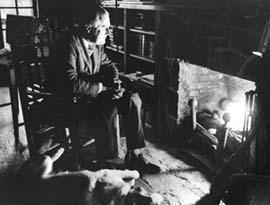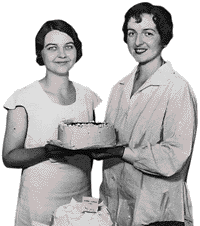By Sharon Boswell
and Lorraine McConaghy
Special to The Times

During the Great Depression, radio programs and newspaper features
made new connections among American families, offering instruction, entertainment
and encouragement. Above, President Franklin Roosevelt meditates before his fireside.
Photo Credit: Acme Newsphotos / Seattle Times
DURING THE 1930S, AMERICANS TURNED INWARD, TO REDISCOVER HEARTH AND HOME.
Drawn together by the common experience of hard times, they shared a renewed sense of the importance of family;
there was, as Dorothy put it in the 1939 film version of "The Wizard of Oz," no place like home. And,
as the grim Depression joke went, home was the one place they couldn't throw you out.
Today, people remember the hungry '30s as the time they never locked their doors and
everyone made do, sharing what little they had. Nostalgic reminiscences recall the simple
pleasures of campfires and hayrides, picnics and fishing trips. Looking at the past through children's eyes,
old folks today remember their Depression community as "one big family," their round of chores as "kinda fun."
In city and country, local families -- Chen, Jackson, Nilsson, Sanchez, Harui, McNeil, Morelli --
shared many experiences.
 After supper, families gathered around their kitchen tables to play
the new games Scrabble and Monopoly, or to try the mysteries of contract bridge,
guided by a new column in The Times. In their living rooms, family members eagerly
leaned toward the speaker of a huge radio cabinet, listening to the dance music of
Fred Waring's Pennsylvanians on KOL, or to "Fibber McGee and Molly" on KOMO. And station KJR
broadcast President Franklin Roosevelt's fireside chats explaining his hopes for the New Deal.
After supper, families gathered around their kitchen tables to play
the new games Scrabble and Monopoly, or to try the mysteries of contract bridge,
guided by a new column in The Times. In their living rooms, family members eagerly
leaned toward the speaker of a huge radio cabinet, listening to the dance music of
Fred Waring's Pennsylvanians on KOL, or to "Fibber McGee and Molly" on KOMO. And station KJR
broadcast President Franklin Roosevelt's fireside chats explaining his hopes for the New Deal.
Quietly battling the crippling effects of polio, FDR encouraged hope by his own daily example
and inspired a sense of personal connection between people and the presidency. During his first
week in office, nearly half a million Americans wrote to him; six years later, he was still
receiving more than 6,000 letters each week. People wrote back to him just like he seemed to
speak to them on the radio: frankly and warmly, from one hearth to another.
Despite the distance in their private relationship, Franklin and Eleanor Roosevelt presented
a public picture of family unity, allowing photographers to record their holiday dinners and
evenings at home. When FDR came into office, the first family's five children were grown,
and Mrs. Roosevelt had swings and a slide built on the White House lawn for her grandchildren.
But she was an independent woman, too.
In 1933, Eleanor Roosevelt published "It's Up to the Women," an anthology of syndicated newspaper
columns that had appeared in The Times and elsewhere. The first lady was heartened that the Depression
had encouraged the rediscovery of family; she argued that women could redeem the nation.
Later in the 1930s, Eleanor Roosevelt's syndicated column, "My Day," spoke out indignantly
on issues of social justice. As first lady, she presented herself as a thoughtful public
woman who nevertheless insisted on time for friends and family.
The Seattle Times joined the national return to hearth and home, and seconded Eleanor Roosevelt's
stirring call to American women. The paper offered its readers a rich, contradictory stew of cliché,
challenge, complacency and consumerism. Times Sunday comics, like "The Gumps" and "Mr. and Mrs."
harped on the tired themes of hen-pecked husbands and dithery wives. But, aside from humor,
1930s domesticity was the province of The Times' Woman's Page, where Virginia Boren and the
fictional Dorothy Neighbors reigned supreme, and family was strictly a woman's issue.
 In the 1930s, the Times' Dorothy
Neighbors department offered readers advice on homemaking, including nutrition and cookery.
"Dorothy," on the right in the photo at left, poses with the proud winner of a
cake-decorating contest.
In the 1930s, the Times' Dorothy
Neighbors department offered readers advice on homemaking, including nutrition and cookery.
"Dorothy," on the right in the photo at left, poses with the proud winner of a
cake-decorating contest.
Photo Credit: Seattle Times
THE TIMES' LONGTIME HOME ECONOMIST, "DOROTHY NEIGHBORS" OFFERED HOUSEWIVES ADVICE on nutrition,
household management, child-rearing and budget. Readers could look forward to an array of regular features on the Woman's Page: the Home Brightener
tip, the Daily Horoscope, Sewing Patterns, Beauty Hints, Appliance Tips, the Dorothy Neighbors' Question Box --
"Is it ever correct to serve soup in cups?" -- and Sally Smart's fashion suggestions. Recipes for Baked Bean
Soup and Macaroni Loaf catered to the tastes and budgets of the '30s.
Dorothy Neighbors blurred the line between advertising and journalism, devising homemaking "classes"
that were thinly disguised promotions. "Dorothy," for instance, staged a tea-party class in which
participants learned the social graces, surrounded by huge signs promoting the sponsoring tea and cookie brands.
However, in the spirit of the first lady, Virginia Boren's society column dealt with women's volunteer
activities more often than with tea parties. Boren reported the charitable activities of Seattle's well-to-do,
and she emphasized the importance of career opportunities for young women. Her support was significant
in a decade when women were expected to resign their positions when they married so they wouldn't
"take" a job from a married man or a single girl.
Many female Seattle journalists masqueraded as Dorothy Neighbors throughout the years;
she was at times matronly, at times youthful, but always cheerful, competent and hospitable --
the heart of her imaginary home.
Longtime Times readers who remember the Great Depression have a mental image of Dorothy Neighbors
that speaks to their own 1930s experience of home and family, to that romanticized time when
everyone knew each other and no one locked the door.
Historians Sharon Boswell and Lorraine McConaghy teach at local universities and do research,
writing and oral history. Original newspaper graphics courtesy of the Seattle Public Library.